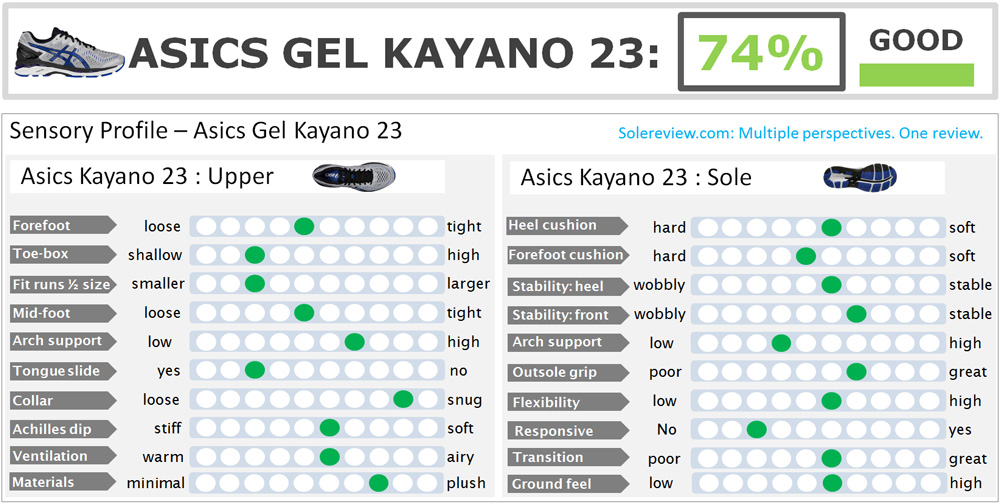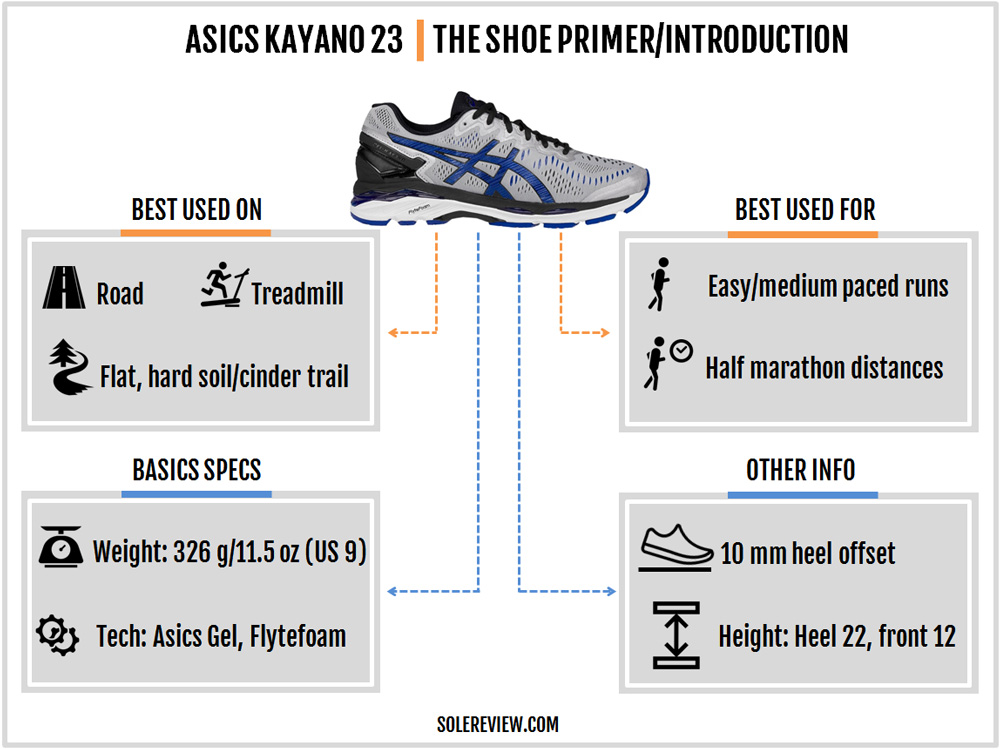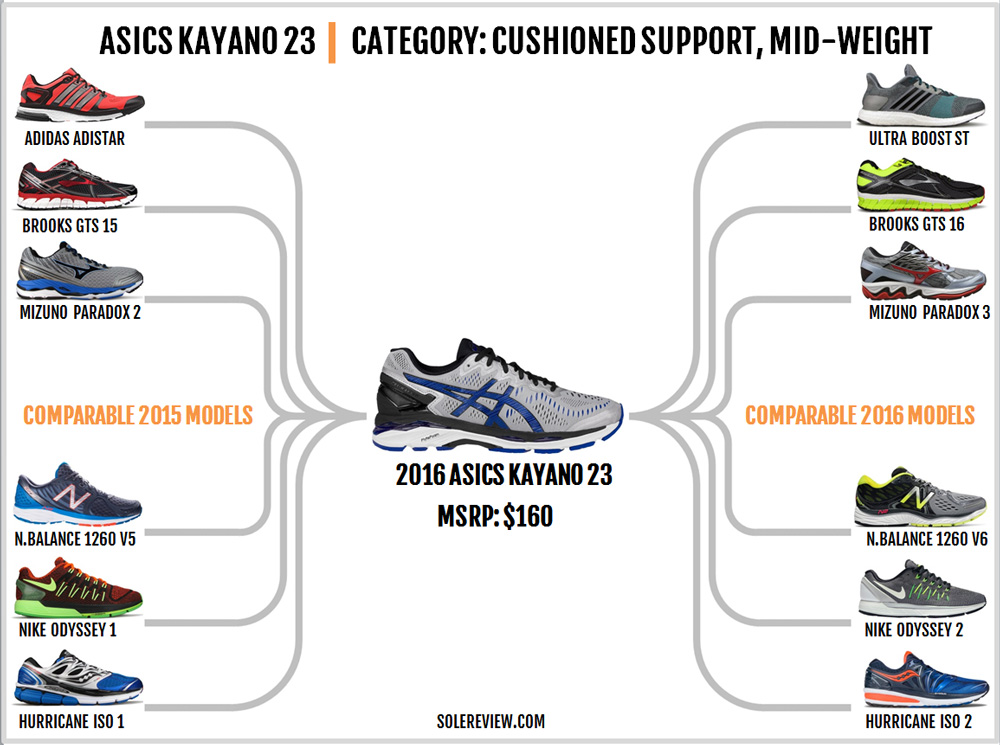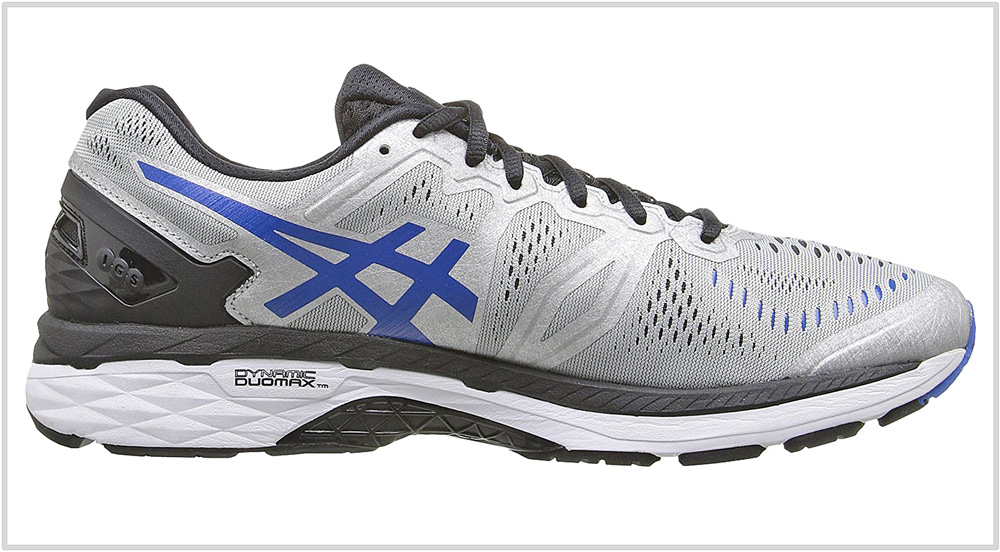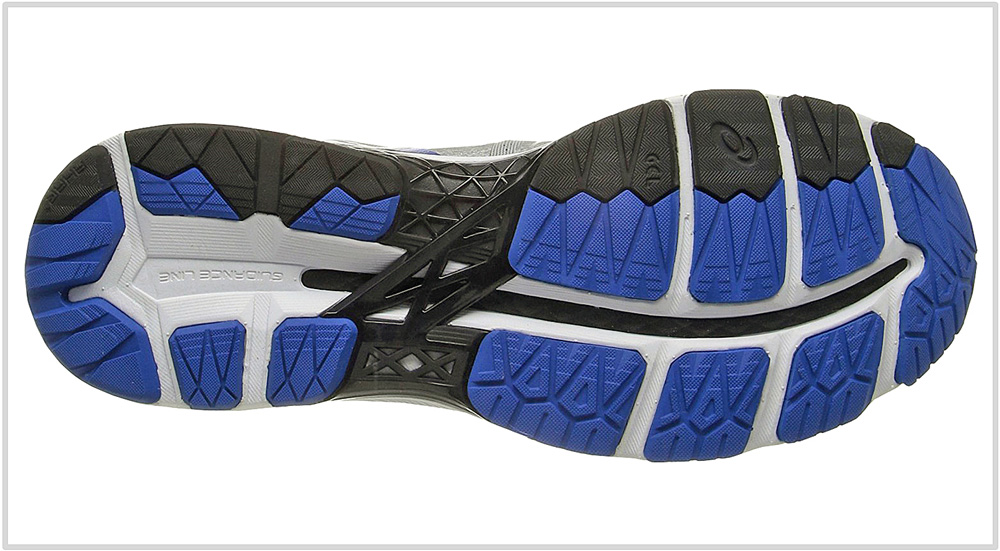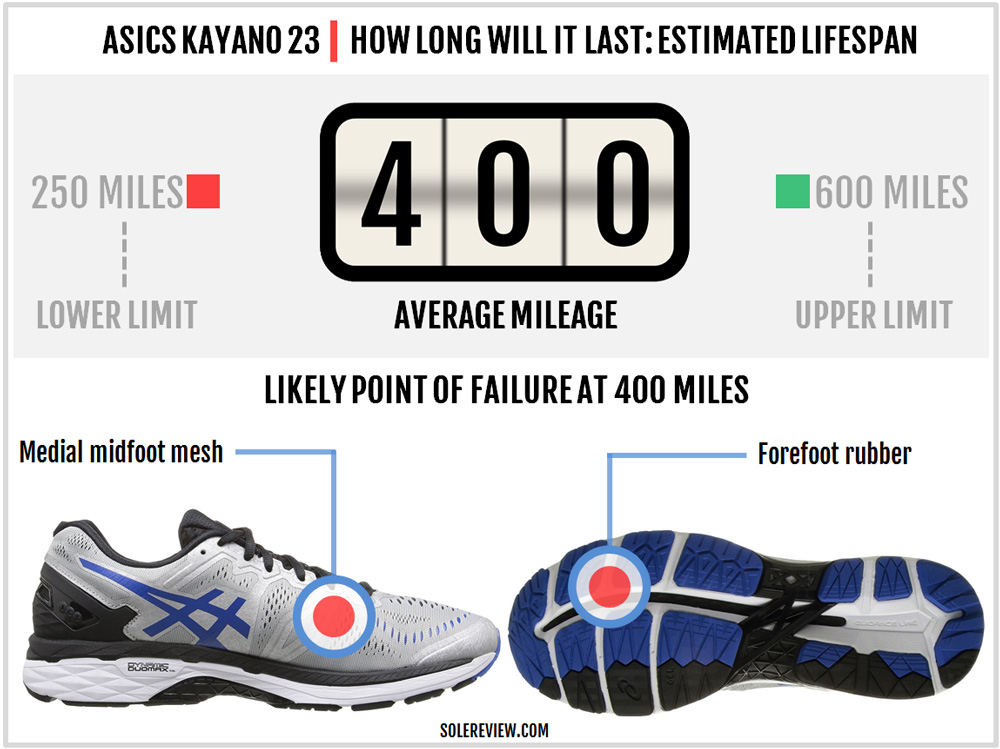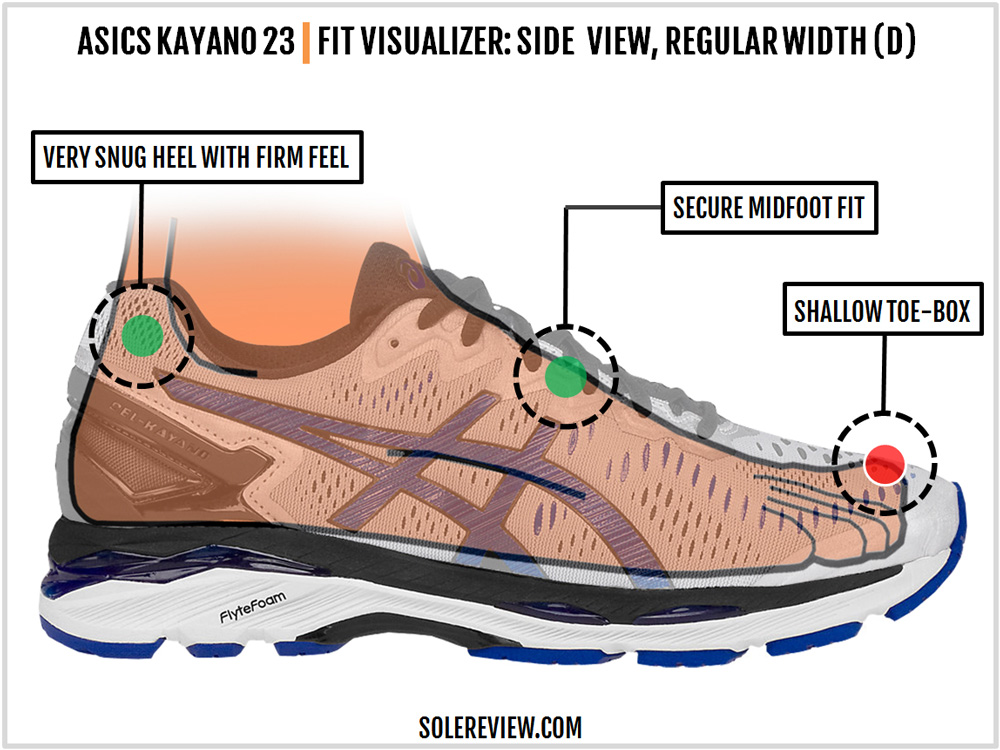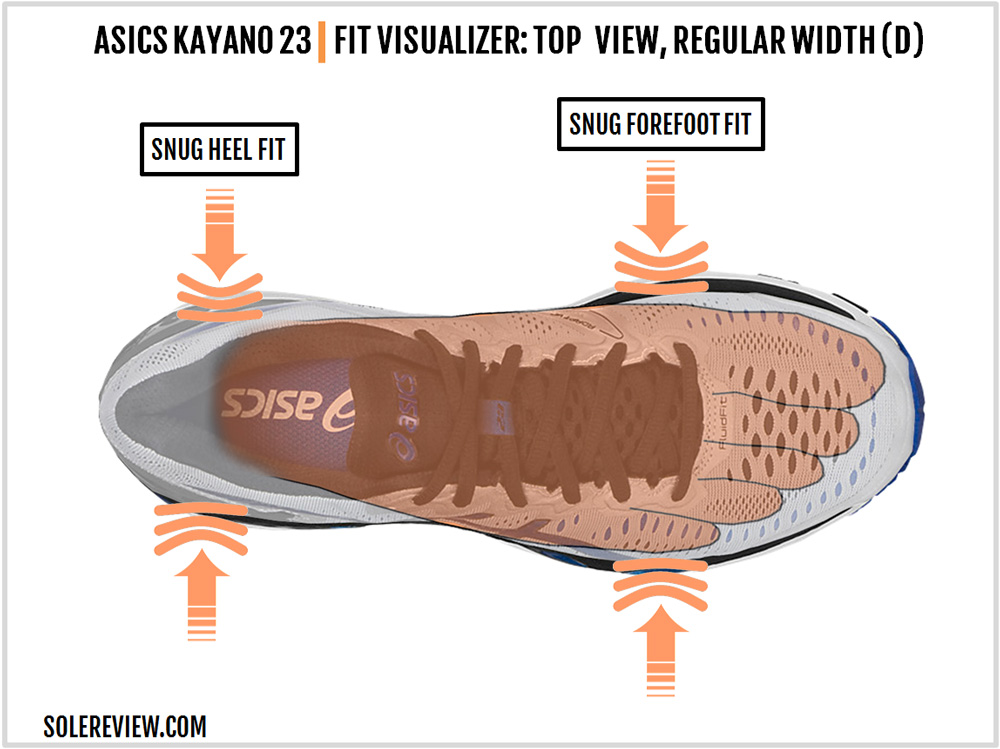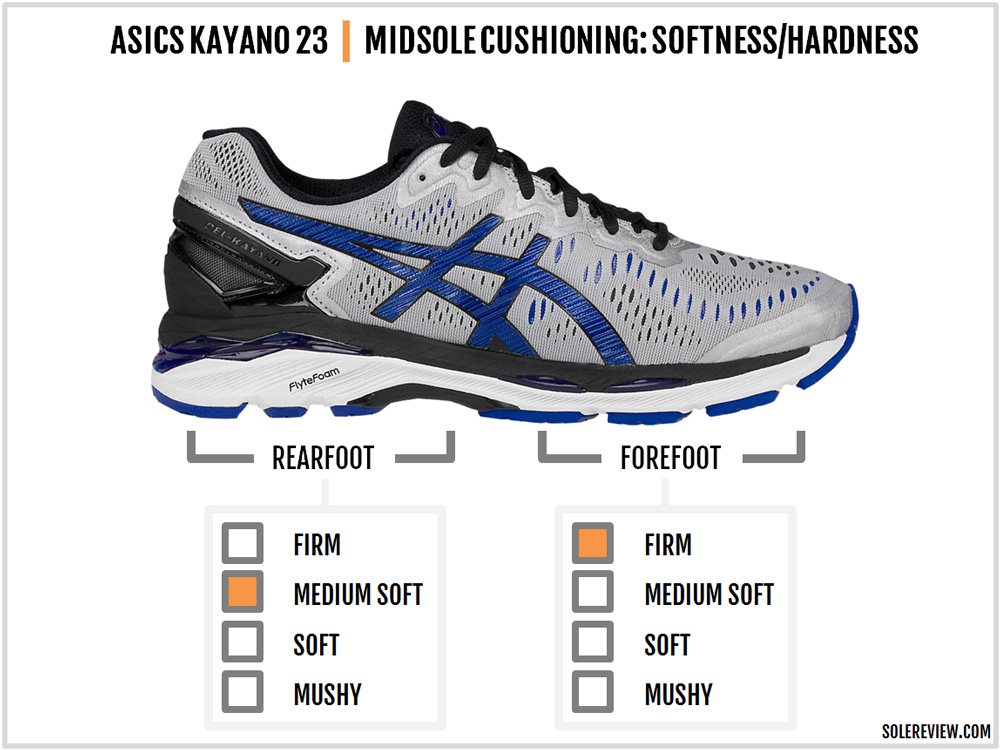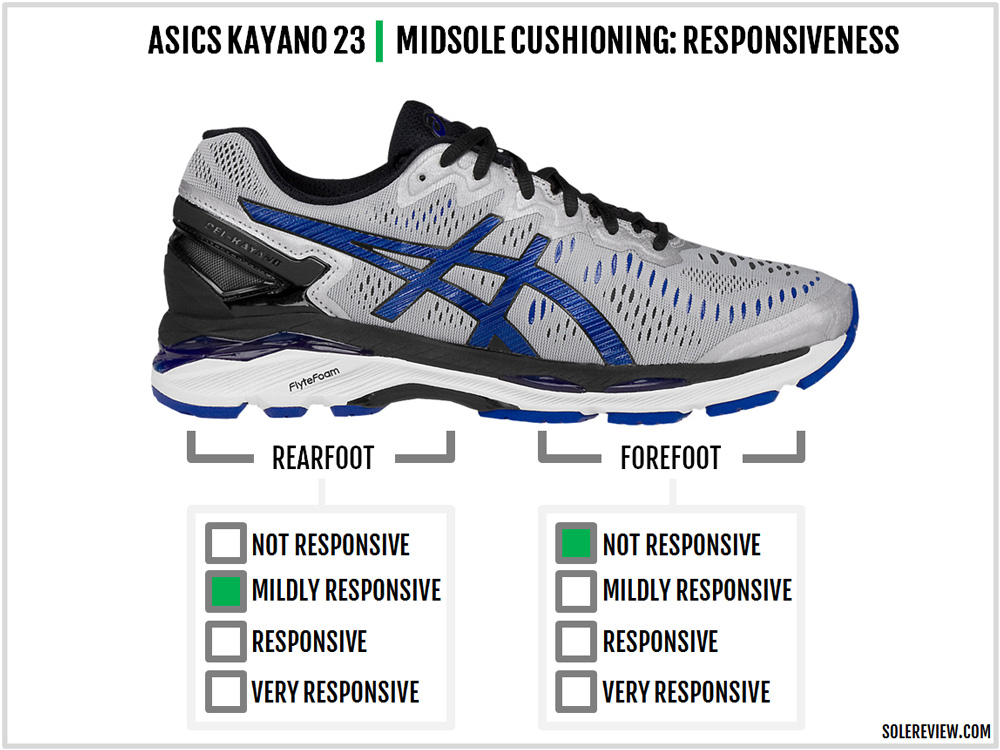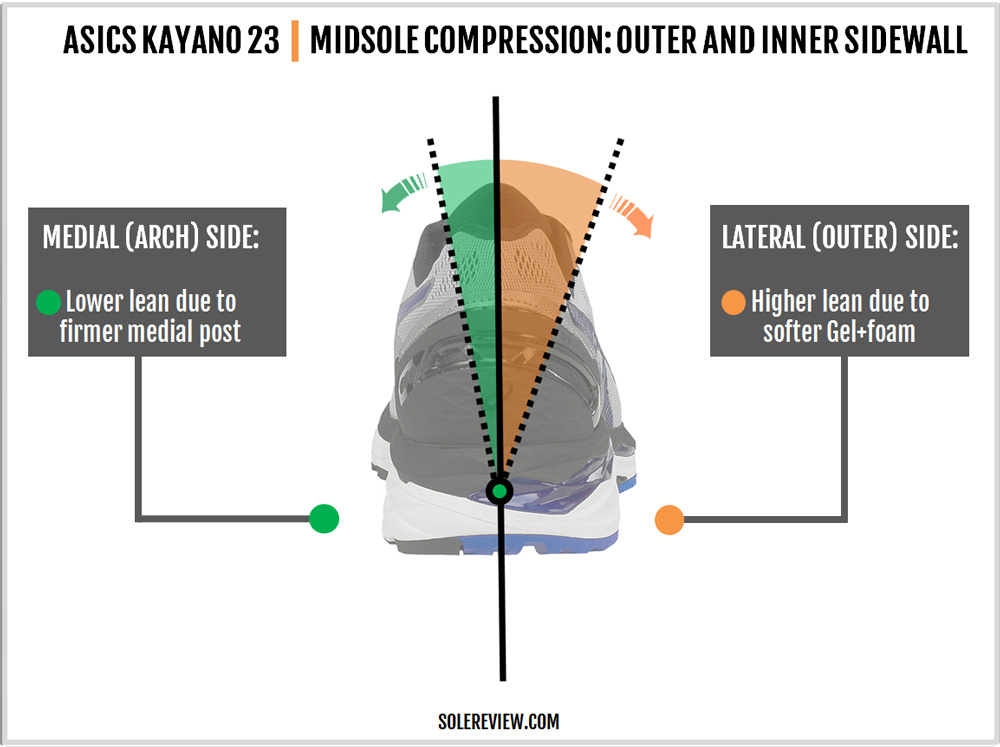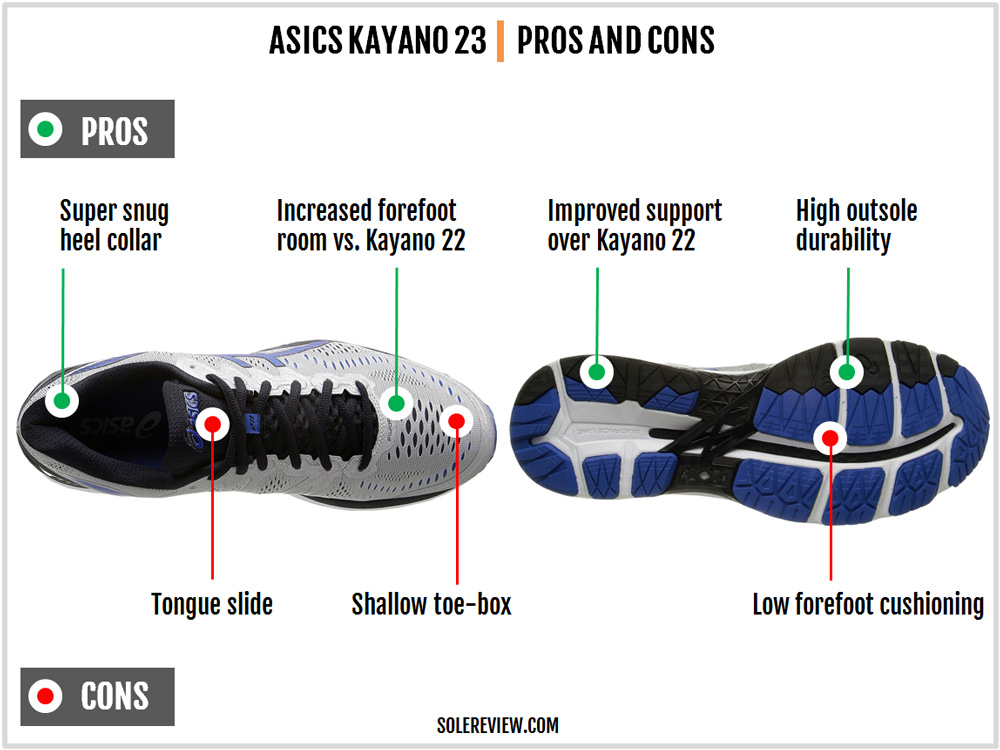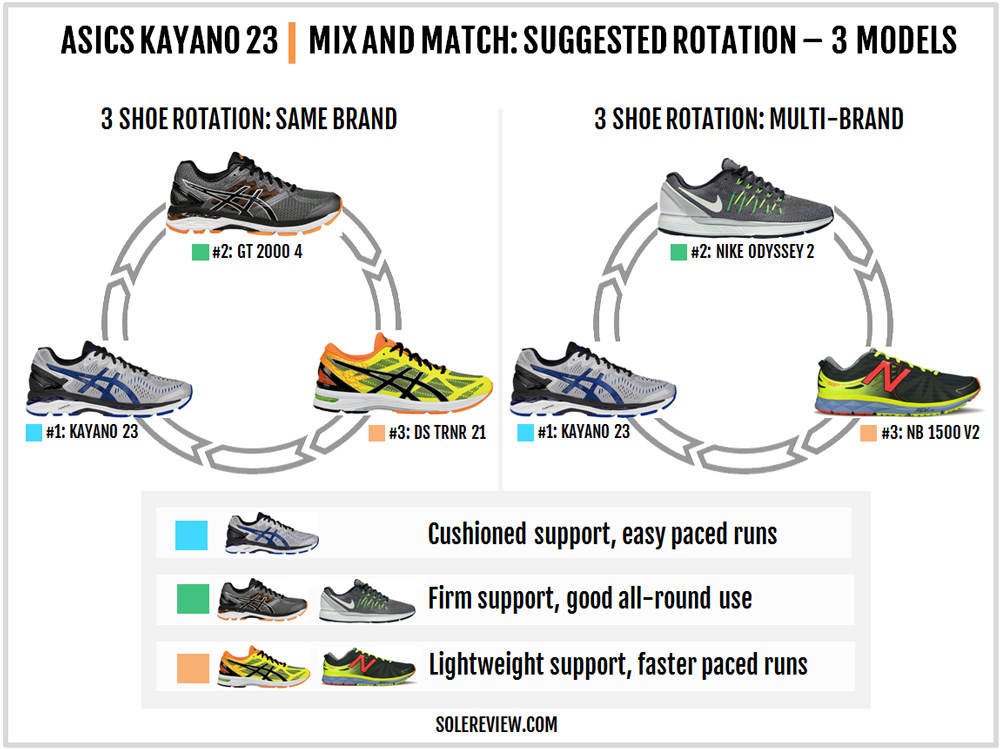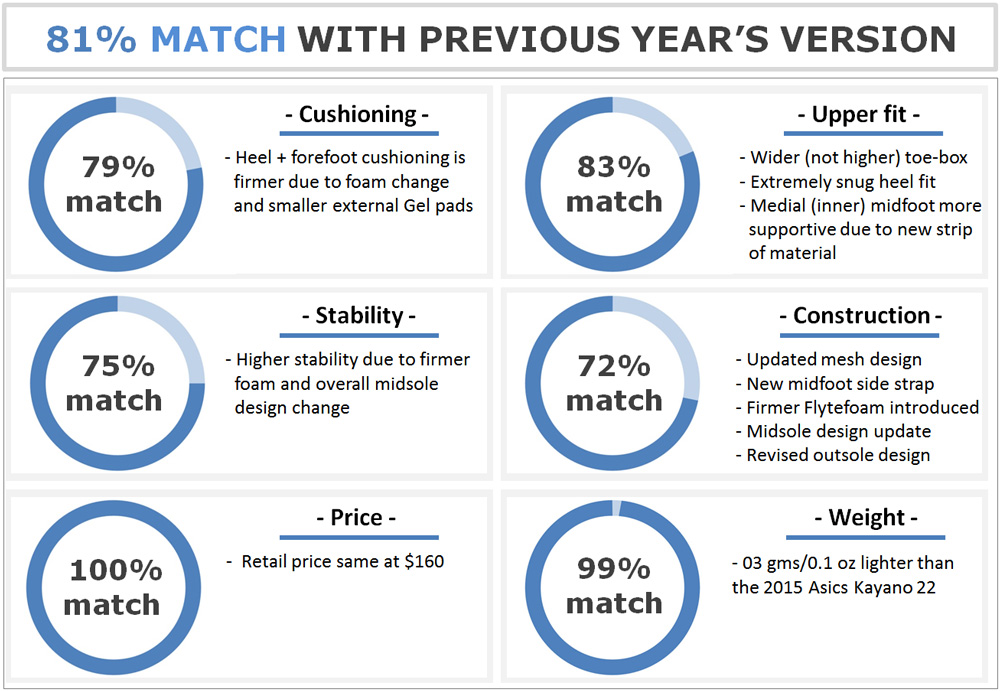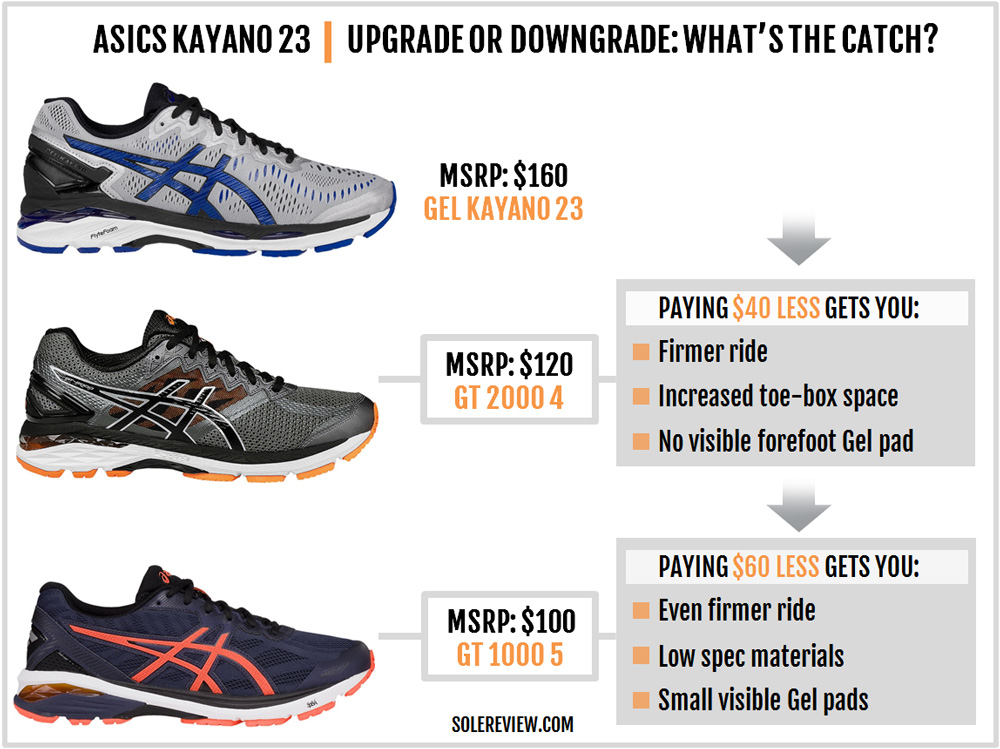INTRODUCTION
Long time Kayano users, here’s a question.
Based on your experience with the past models, what is your ideal of the Asics Gel Kayano? Would it be akin to the firm Kayano 17 and 18 with a relatively spacious upper fit? Or would you prefer the softer 19, 20 and 21?
If you ask solereview, then we’d choose the Kayano 21. It was softer than the Kayano 19 and 20 but did not go overboard with the cushioning softness. And compared to what passes for a Kayano these days, the 21 had a well fitting upper with optimal toe-box proportions.
The 2015 Kayano 22 was a puzzling update. Asics took an already soft Kayano and made it even softer; to the point that the 22 delivered a mushy ride producing sleepy transitions. And that wasn’t even its worse sin; the honor went to the wobbly midsole which was completely lacking in stability.
All that softness made the Kayano 22 the opposite of a support shoe. We were so unimpressed that we straightaway told you to ignore the 22 and stock up on the 21 instead.
Thankfully, Asics might have realized the irony of it all, and the Kayano 23 backtracks on some of the Kayano 22’s structural faux pas. While certain parts of the Kayano 23 still needs improvement, at least it is far from being the complete mediocrity which the 22 was.
So what’s changed on the Kayano 23? It’s got a much firmer ride, and a toe-box fit quality which is half way between the 21 and the 22. We’ll dive into greater detail during our upper and ride break-out.
At an MSRP of $160, the Kayano 23 occupies the top price tier within Asics’ premium support category. Of course, every brand has their own $140~$160 cushioned-support hero, so we’ll talk briefly about some of the available models.
Till last year, adidas’ top-dog in this category was the adistar Boost ESM. This shoe combined their legacy Formation heel insert and Boost along with a firmer medial midsole.
However, this is 2016, and the adistar ESM is gone. Replacing it is the cushioned Ultra Boost ST with its near-neutral manners. The Adistar ESM to Ultra Boost ST succession is similar to the whole Brooks Trance-Transcend deal, if you know what we mean. Speaking of which, the Brooks Transcend 3 can also be considered an alternative – just not in the traditional medial post sense.
But fret not, there are plenty of other options with the old-school medial post. For example, you have the very firm Brooks Adrenaline GTS 16. Nike offers the firm riding and somewhat responsive Nike Odyssey 2.
The New Balance 1260 V6’s ride quality is somewhere between the Kayano and the Odyssey. And Mizuno, of course, does its Wave plate thing with the Paradox 3 at a reasonable $140 MSRP.
Saucony’s Everun infused Hurricane ISO 2 competes with the Kayano 23 at the same price, but with a more responsive ride and a better fitting upper.
DESIGN AND MATERIALS
The 2015 Kayano 22 was a complete reworking of the franchise model, marking the design transition from the Kayano 21’s cut-and-stitch design to an engineered mesh based upper.
The Kayano 23 takes the same engineered mesh template and makes a few changes. Right in the front, the external overlays which ran over the K-22’s forefoot have been removed.
Even with the strips gone, the forefoot isn’t entirely unsupported. Like the Kayano 22, the 23 uses an internal backing material, just not in the same place. While the K-22’s internal backing ran diagonally over the forefoot, the ones inside the K23 runs lengthwise over the toe-bumper to the midfoot.
Though the Kayano 23 uses engineered mesh, it is a slightly different kind than the K-22’s. The mesh over the forefoot is a lot more open in structure.
In many ways, the upper reminds us of the Asics Quantum 360. Engineered mesh, nearly no overlays, molded eyestay – that kind of aesthetic similarity.
The eyelets are a part of the fused synthetic panel like last year, and the lateral midfoot is free of layers except for the Asics logo. Near the rearfoot, the K-23 cuts down on synthetic usage. The last two eyelets no longer connect to the heel counter using a synthetic strip.
Synthetic usage around the Achilles dip is reduced, hence making that part softer. On the Kayano 22, the synthetic extended high up, just short of the Achilles dip.
On the medial/arch side of the upper, the Kayano 23 introduces a new design element. There’s a midfoot strap just under the second eyelet. Asics calls this ‘adaptive stability,’ claiming to support the arch side of the foot.
The external heel counter has been updated. Instead of the large open windows seen on the K-22, the medial side is now filled up solid. And you know what that means – the amount of reflectivity has decreased compared to last year.
There’s a change in the heel counter molding too. If you view the Kayano 22 and 23 together from the top, then you’ll notice that the heel opening for the 23 is molded narrower. Naturally, this sort of a thing has consequences for the quality of fit.
Asics has always been averse to midfoot sleeves, and the Kayano 23’s tongue stays true to tradition by not using an inner sleeve. The tongue does have a central lace-loop, but it is ineffective when it comes to preventing slide.
While the Kayano 23’s upper does have a few updates, all major changes happen underneath in the form of the new midsole design.
Remember the much hyped Asics Metarun? While that shoe did not exactly set the sales chart on fire (hint: $250 MSRP), there’s been a trickle-down of design features to other reaches of Asics’ assortment.
In the Kayano 23’s case, it’s the new midsole material called Flytefoam. While the exact material specification is vague, the gist is that it’s EVA foam ‘blended with some fibers,’ in an attempt to increase durability and reduce weight. Based on outward appearances, Flytefoam looks and feels like EVA, but with a wrinkly texture.
What’s instantly noticeable on the Kayano 23 is the significant increase in firmness across the board. The black section of the midsole foam is super firm, and the white Flytefoam below is also firm.
As a whole, the Kayano 23 isn’t any lighter than the 22, so Flytefoam’s extent of contribution to weight reduction is still unclear. An increase in durability is always welcome, because regular EVA (like what Asics has used in the past) will eventually lose its cushioning properties.
A few other updates will catch your eye. The Kayano 23, like the past few versions, uses a three layer stack of foam-gel-foam to construct its midsole.
While the basic set-up has remained unchanged, the size of visible Gel pads has decreased on the lateral side. The forefoot Gel pads are smaller, and the heel Gel shrinks on the side but increases under the heel edge.
The firmer medial post (Duomax in Asics speak) comes blended into the midsole, as is expected of the Kayano.
Inside, there’s the combination of the soft blown-foam insole and lasting. It is important to know that the Kayano 23 does not have arch support inside the shoe; the insole itself is flat and only slightly flared on one side.
The outsole layout is virtually identical to the Kayano 22 except for some minor tweaks. The transition groove – seen as the exposed strip of black foam in the outsole picture – is shorter than the Kayano 22.
Right under the toe area, the piece of rubber used is smaller than the Kayano 22, and some of the outsole pieces have these flex grooves molded into the sides. The outsole rubber slabs are also angled forward compared to the K-22.
Historically speaking, most Asics shoes have displayed above-average levels of durability, owing to the built-up design approach. You know, things like lots of outsole rubber, upper layering and all that.
In recent times, Asics is trying hard to shed that image, jumping on the minimal design bandwagon. While the lower parts of the shoe are still constructed using multiple density foam stacks and copious amounts of outsole rubber, the upper sees a lot of stripping down.
We’re not implying that engineered mesh based uppers are flimsy. In most cases, these uppers are reinforced with a fabric lining inside and have proven as durable as their cut-and-stitch peers.
The Kayano 23 uses an engineered mesh upper backed with an inner lining, but there is one particular area where one needs to keep an eye on. The medial side of the mesh has this (external) synthetic strap running vertically.
Over time, repeated flexing of this strip can potentially produce a stress area, resulting in a slight chance of mesh tear.
The outsole has a lot of rubber and will be good for around 400 miles. As is the nature of things, the softer forefoot rubber will wear off faster than the harder heel material.
Long term durability is yet unknown for the Flytefoam compound vs. regular Asics EVA foam. We’ll update this section when additional wear-test data becomes available.
UPPER FIT AND FEEL
Something drastic happened to the Kayano 22’s fit. That something was a toe-box squashed to a much shallower height; this was a massive shift from the comparatively roomy environs of the previous Kayanos.
The Kayano 23 is still shallow like the 22, except that your toe is no longer hemmed over by the fused strip over the toe-box. So can we call this improvement? Kinda.
Though the basic midfoot material is nearly identical to the K-22, the medial (arch side) midfoot has a snugger fit. This happens entirely due to the new synthetic panel fused over the mesh.
Some runners will find this strap to be a pressure point; others might not. It depends on the individual foot shape and the kind of socks worn with the Kayano 23.
Right at the back, the Achilles dip area is softer because of more mesh and less synthetic. And the updated (narrower) external counter design increases the level of collar grip.
The toe-box gets a width increase. This makes the 23 slightly less pointy than the 22, but just know that the room increase is biased towards the small toe side than near the big toe.
The forefoot is still snug, with a few differences. The lack of overlays makes the fit marginally more accommodating than the claustrophobic Kayano 22, and the revised placement of the internal support strips also helps ease up the fit.
As mentioned in the upper breakout, the external heel counter is molded narrow. This has two effects. Firstly, it’s a no-brainer that the heel fit becomes tighter; for some runners, this might end up being too much of a good thing.
The second effect is a slightly shorter sizing. It’s not to the extent of half a size, but more like 1/3rd of a shoe size. We’ve seen narrow counter molding pushing the foot forward on many other shoes, and the Kayano 23 behaves similarly.
RIDE QUALITY AND BEHAVIOR
Due to the drastic change in foam density, the Kayano 23 is much firmer than the outgoing 22. While the shoe is cushioned, there is an overbearing tone of firmness which was conspicuous by its absence last year.
The top part of the midsole (in black) is firm bordering on hard, and the Flytefoam has a firm quality as well.
One thing you should know about the K-23 is that its cushioning has a strong rearfoot bias. This becomes evident when you run in them; the rearfoot seems to have gobs of material underneath while the forefoot (under the ball of the foot) comes across as foam deprived.
The stack heights published by Asics explains the cushioning disparity. The forefoot has a mere 12 mm stack while the heel is 22 mm thick – nearly double the forefoot height. This becomes a concern when you’re pushing longer distances on the Kayano 23. You begin the run thinking that the ride is going to be adequately padded throughout, but you realize half way that the forefoot isn’t as cushioned as expected.
And once the foam insole and lasting go Tortilla flat after a few hundred miles, then the forefoot ride is going to feel even flatter.
There used to be a time when the Kayano displayed some traits of a responsive ride. This was back in the day when the Kayano was a firm riding shoe, and you could get feedback from the multi-density midsole.
Over the years, the Kayano has become a big softy; so much so that the Kayano 22’s ride was unmistakably mushy. The Kayano 23 is firmer owing to the Flytefoam material, but the material lacks noticeable rebound behavior. The heel has traces of it, but that’s all there is to it.
From the sound of Asics’ PR brief on Flytefoam (first seen on the Metarun), increased responsiveness does not seem to be one of Flytefoam’s publicized forte. Rather, durability and weight reduction are.
The Kayano 23 is firmer, and hence stability gets a solid boost. The Kayano 22 had a wobbly ride; thankfully the Kayano 23’s roadside manners are far better.
Being in the motion-control footwear category, the Kayano does what most of other shoes in this category do. The rearfoot midsole’s compression is biased towards the lateral (outer) side.
The firmer foam wedge integrated into the medial side helps arrest midsole compression. On the lateral side, the softer foam and Gel pads result in a cushioning bias.
Transitions feel more connected on the Kayano 23 because of, you guessed it, the firmer ride. The Kayano 22’s mushy ride felt like running in a shoe made of putty dough.
Forefoot flexibility decreases here, and that’s merely stating a fact. It is neither a good thing or bad; in fact, a stiffer forefoot helps with quicker transitions. On the other hand, the Kayano 23 will require a few weeks to properly break-in.
PROS AND CONS
The Kayano 23 is an overall improvement over the 22. The firmer ride and the corresponding increase in support is a definite functional upgrade over last year.
Among other update areas, the toe-box goes slow on the pointy-ness and opens up some room on the small toe side. Then there are the standard Asics advantages, like the outsole covered generously with rubber.
The toe-box is still shallow in height, which will disappoint runners who were used to the toe-box spaciousness of the Kayano 21 and earlier. The $160 shoe still has no inner sleeve, so the tongue slide is a part of the typical Asics experience you’ll have to put up with.
As mentioned, the Kayano is padded but focused only under the rearfoot. There’s nothing wrong with a firm forefoot, but we have to remember that the Kayano is meant to represent the premium cushioned-support category.
RECOMMENDED ROTATION
Asics offers the widest variety when it comes to running shoes with firmer medial posts. So if you’re looking to rotate a couple of other models with the Kayano 23, suitable companions are close at hand.
The GT-2000 4 offers a slightly firmer ride than the Kayano 23, and you get the fit benefit of a traditionally designed roomy toe-box.
In case you feel the need for a higher level of support than the Kayano or GT 2000 4, then consider the Gel Foundation 12.
True to its name, the Foundation 12 is a very stable shoe without the aesthetic frills of the visible Gel, and has reduced midsole bias. The medial post is sizable and extends gradually from the heel to forefoot.
On the faster end of the scale, you can either opt for the proven DS Trainer 21 or the lighter and race-oriented DS Racer 11. Both these shoes have a medial post and complement the Kayano nicely.
Outside of Asics’ stable, there are plenty of options. So much so that it’s hard to pick only three, but we’ll give it a stab.
The Nike Zoom Odyssey is a firmer, more responsive support shoe which happens to be in the same category as the Kayano but is sufficiently differentiated. If you’re not into Nike, then consider the Saucony Hurricane ISO 2 instead.
For faster paced workouts, our pick would be the New Balance 1500 V2. Not only does it ride beautifully, but also comes with an excellent upper fit.
SUMMARY
The Kayano 23 has a substantial number of updates, and they all distil down to two things. The midsole ride is much firmer, which makes the Kayano 23 more supportive in nature than the 22.
Secondly, the design reworking of the upper leads to a corresponding change in upper fit quality. The toe-box and forefoot are comparatively easygoing, and the heel fits narrower.
The Kayano 23 resides at the very top of the cushioned-support category. So an upgrade path isn’t available; the only way is down.
For a $40 knock off the MSRP (which we think to be great value), you have the firmer GT-2000 4. It does pretty much everything which the Kayano 23 does, and offers a spacious toe-box and a traditional cut-and-stitch upper design.
A further toned-down version is the $100 GT-1000 5 with an even firmer ride. We don’t recommend the GT 1000 5 over the 2000, however. It is evident that the shoe is built to a price; the materials lack the plushness of more expensive models, and in some parts the shoe feels downright stiff and raspy.
The way things stand today, the GT 2000 4 offers the best value within Asics’ cushioned support assortment.

